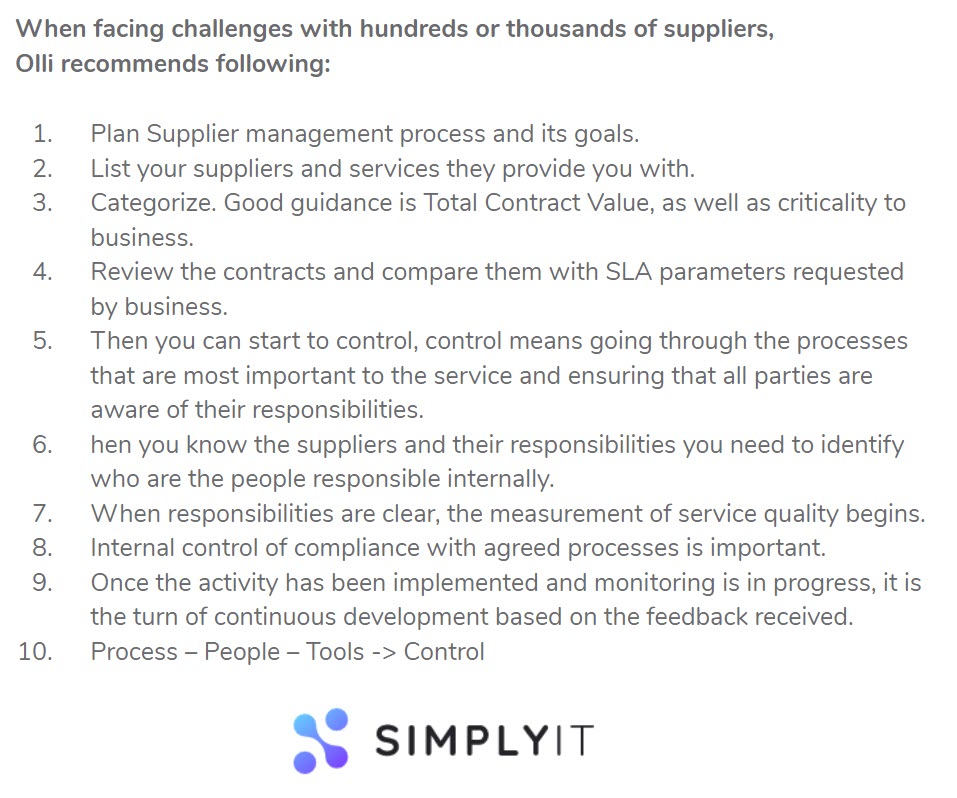First real life story about SIAM with Olli Rantala
Olli is working for a Finnish public IT supplier serving the healthcare system in Finland. He is a member of the Service Management Office (SMO) and his responsibility as Development manager is also for IT Supplier Management.
Olli has been one of the first main influencers of SimplyIT.cloud with his valuable feedback and ideas for the tool development.
Here is an interview with him about his thoughts on IT Service Management and SIAM.
Can you shortly introduce your journey in IT Service Management? And can you tell us what is your current company 2M-IT doing?
I have been working for more than 20 years in IT and always around IT Services. When I was in school, I was convinced I would work with computers. Naturally, my first job has been onsite support where I took care of workstations, servers, network and everything around basic IT. Soon after that, I started to work for IBM as a Service Desk agent, where I first got in touch with ITIL based processes. At that time, I did not fully comprehend their purpose. Then, I moved to second line support and it started to make more sense how incidents are connected with problem management.
After that, I moved to Fujitsu where I got responsibility over offshore delivery which is when I really started to understand the full lifecycle of ITSM processes. These processes have been the only way to enforce the quality of delivery remotely.
The transition to my current role was through Medbit where my service area was the workstation lifecycle management. After a merger where 2M-IT was established, I got the opportunity to participate in the design of the service catalog, developing the organization’s IT Services reporting model and create a supplier management process in 2M-IT.
What does the abbreviation SIAM means to you, and how it affects your daily work life?
For me, SIAM means bundling complex services and suppliers into one manageable entity.
In my work, SIAM is manifested through processes and the ITSM tool. Services need to be looked at more broadly than just as a single provider. For example measuring service level management for a one service has to cover multiple service providers. The work is not yet complete but the goals are clear and step by step we will reach those goals.
SIAM ensures visibility from end to end service performance regardless of whom is provisioning them. Businesses and suppliers together establish the end to end measures and reporting of services. Based on that you can calculate real costs, SLAs and you can gain control. Control is the main key word here.
What is the role of 2M-IT in SIAM?
2M-IT is in a unique situation. We are not internal IT, we are co-owned by our customers. It means that we are like in-house service provider that provides services together with external service providers. In the future, our role as a leading supplier will be strengthened.
How important is Service Catalog in your opinion in an environment with many suppliers and business stakeholders?
The Service Catalog is the core of the entire service delivery. Without a Service Catalog, managing services is not efficient from a cost and production point of view. The Service Catalog also clarifies the responsibilities and obligations of service providers.

Without the Service Catalog we would be in deep sh**, ehm troubles. Without the Catalog we wouldn’t understand what kind of services were provided to us by the providers. In addition, without the Service Catalog we wouldn’t know what services we provide to our customers. Service Management Office couldn’t exist without it either.
When meeting the first time, you mentioned 2M-IT having thousands of suppliers causing you a challenge. Can you elaborate on this?
Yes, I had just started planning a supplier management process. I had a list of companies that provided services or parts of a service, with almost a thousand companies listed.
The problem is when we would like to implement standards like e.g. ISO 20000. The first thing was that it would not be possible or even sensible to apply the requirements of the standard to every supplier. 2M-IT has about 500 employees, so there are two companies for every employee.
The conversations we went through were really helpful and got me started on the job.
The way to handle this is by categorisation of suppliers into different tiers. Now, we have 5 levels of suppliers Critical, Strategic, Tactical, Operational, or Task related. Thanks to the categorization of suppliers we can focus on the right things.
Integration of the ITSM tool with other service providers is also underway.
